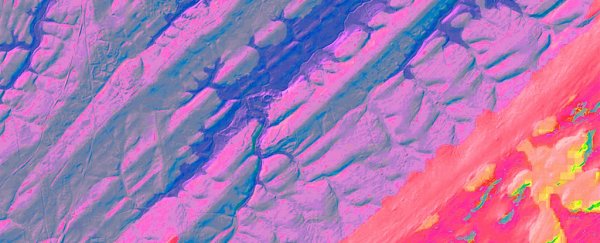When it comes to understanding the history of the Solar System, a whole lot of clues to its past lie in the geological records right here on Earth. New research stretches that link back some 200 million years using what scientists are calling a Geological Orrery.
You've probably seen an orrery before – it's one of those mechanical models of the Solar System where the Sun and the planets spin around like a clock – but in this case the calculations are being extended to the real Universe rather than a desktop model.
The aim of the new study is to piece together the movements of the planets going back hundreds of millions of years, using the records left in the rocks on Earth to judge planetary tilting, gravitational pull, and other aspects of the complex cosmic dance of our neighbourhood.
The thinking is that geological data helps us be more specific in our measurements of how the Solar System looked millions of years ago – a way of cutting through the chaos, variability, and uncertainty involved in the maths of modelling the Solar System.
"The Geological Orrery is the opposite of an equation or model," says the leader of the team, geologist and paleontologist Paul Olsen from Columbia University in New York. "It's designed to provide a precise and accurate history of the Solar System.
"We get that history right here on Earth, from the history of our climates, which is recorded in the geological record, especially in large, long-lived lakes."
Underpinning this Geological Orrery is the idea that slight variations in the Solar System have an impact on every part of it. The orbit and axis orientation of Earth are always being slightly altered by the movements of our celestial neighbours - changes technically known as Milankovitch cycles.
 Paul Olsen at one of the study sites at Arizona's Petrified Forest National Park. (Kevin Krajick/Earth Institute)
Paul Olsen at one of the study sites at Arizona's Petrified Forest National Park. (Kevin Krajick/Earth Institute)
These cycles affect our planet's relationship with the Sun – so if our geological records show the distribution of sunlight reaching Earth, and the state of our climate over time, it should be possible to work backwards to figure out the positions of other planets, too.
Current modelling techniques can only plot the past movements of our Solar System to a period of around 60 million years, so being able to go back 200 million years is a big jump in our understanding – and the Geological Orrery is only just getting started.
"What is new here is the systematic approach of taking rock cores spanning tens of millions of years, looking at the cyclical sedimentary record of climate and accurately dating those changes over multiple sites," says Olsen.
"That allows us to capture the full range of Solar System-driven deformations of our orbit and axis over long time periods."
Using ancient sediments extracted from Arizona and New Jersey, the team was able to spot a cycle in Earth's orbit lasting 1.75 million years, on top of smaller cycles identified in the researchers' previous work.
That big cycle seems to have lengthened in the modern era, and shifts between Earth and its neighbour Mars could explain it – proof of the Geological Orrery in action.
"The shorter cycles are about the same today, but the 1.75 million-year cycle is way off – it's 2.4 million years today," says one of the team, geochemist Jessica Whiteside from the University of Southampton in the UK.
"We believe that this difference is caused by a gravitational dance between Earth and Mars and represents a fingerprint of solar system chaos."
The Geological Orrery can be used to test other datasets and models of space, and could eventually be useful in examining some of the fundamental rules of the Universe – Einstein's general theory of relativity and dark matter, for example, or anything where gravity plays a crucial role.
It might also be useful in helping to spot planets that were once in our Solar System but have since disappeared. However, it's still early days in the research, and a lot of the assumptions behind the new Geological Orrery are yet to be tested.
Olsen himself has been working on the idea for more than 30 years now, and has big plans for the Geological Orrery: more rock cores taken at more locations around Earth would help fill in some of the gaps in our knowledge.
And with more data it should be possible to test the accuracy of the Orrery against data we already have on planetary interactions – including the previously mentioned effects of gravity on the movements of Mars and Earth.
"That would be a full proof of concept of the Geological Orrery," says Olsen. "I plan to certainly be around for that."
The research has been published in PNAS.
